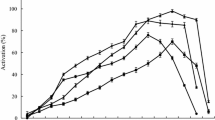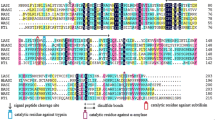Summary
A simple and efficient medium for callus tissue culture from garlic to obtain maximal proteolytic activity is described. Murashige and Skoog basal medium supplemented with 4.44 μM naphthaleneacetic acid (NAA) and 0.54 μM benzyladenine (BA) resulted in the best biomass production and protease expression. The protease activity belongs to the class of cysteine proteases since they are inhibited by E64 and Leupeptin and also they are activated by 2-mercaptoethanol and cysteine. They showed good thermal stability. Three active protease bands were found in zymograms of Allium sativum. The in vitro system revealed a significantly higher protease level than storage and embryo tissues of in vivo bulbs.
Similar content being viewed by others
References
Adam, Z. Chloroplast proteases; possible regulators of gene expression? Biochimie 82:647–654; 2000.
Agarwal, K. Therapeutic actions of garlic constiuents. Med. Res. Rev. 16:111–124; 1996.
Barandiaran, X.; Martín, N.; Rodriguez-Conde, M. F.; Di Pietro, A.; Martín, J. An efficient method for callus culture and shoot regeneration of garlic (Allium sativum L.) Hortscience 34(2): 348–349: 1999a.
Barandiaran, X.; Martín, N.; Rodriguez-Conde, M. F.; Di Pietro, A.; Martín J. Genetic variability in the callogenesis and regeneration of garlic. Plant Cell Rep. 18:434–437; 1999b.
Barone, F. E.; Tansey, M. R. Isolation, purification, identification, synthesis and kinetics of activity of the anticandidal component of Allium sativum, and a hypothesis for its mode of action. Mycologia 69:793–825; 1977.
Beers, E.; Woffenden, B.; Zhao, Ch. Plant proteolytic enzymes: possible roles during programmed cell death. Plant Mol. Biol. 44:399–415; 2000.
Cavallito, C. J.; Bailey, J. H. Allicin, the antibacterial principle of Allium sativum L. Isolation, physical properties and antibacterial action. J. Am Chem. Soc. 66:1950–1951; 1944.
de Fossard, R. A. Tissue culture for plant propagators. Armidale, Australia: University of New England Pritery: 1976:409.
Eilat, S.; Oesraicher, Y.; Rabinkov, A.; Ohad, D.; Mirelman, D.; Bautler, A.; Eldar, M.; Vered, Z. Alteration of lipid profile in hyperlipidemic rabbits by allicin, an active constituent of garlic. Coron. Artery Dis. 6:985–990; 1995.
Estelle, M. Proteases and cellular regulation in plants. Curr. Opin. Plant Biol. 4:254–260; 2001.
Feldberg, R. S.; Chang, S. C.; Kotik, A. N.; Nadler, M.; Neuwirth, Z. C.; Sundstrom, D.; Thompson, N. H. In vitro mechanism of inhibition of bacterial cell growth by allicin. Antimicrob. Agents Chemother. 32:1763–1768; 1988.
García Carreño, F.; Dimes, L.; Haard, N. Substrate gel electrophoresis for composition and molecular weight of proteinases or proteinaceous proteinase inhibitors. Anal. Biochem. 214:65–69; 1993.
Hershko, A.; Ciechanover, A. The ubiquitin system. Annu. Rev. Biochem. 67:425–479; 1998.
Kleiner, D.; Stetler-Stevenson, W. Quantitative zymography: detection of picogram quantities of gelatinases. Anal. Biochem. 218:325–329; 1994.
Kochler, S. M.; Ho, T.-H. D. Hormonal regulation, processing and secretion of cysteine proteinases in barley aleurone layers. Plant Cell 2:679–783; 1990.
Krupa, J. C.; Mort, S. J. Optimization of detergents for assay of Cathepsins B, L, S and K. Anal. Biochem. 283:99–103; 2000.
Lam, E.; del Pozo, O. Caspase like protease involvement in the control of plant cell death. Plant Mol. Biol. 44:417–428; 2000.
Lau, B. H. S.; Yamasaki, T.; Gridley, D. S. Garlic compounds modulate macrophage and T-lymphocyte functions. Mol. Biother. 3:103–107; 1991.
Lin, Y. W.; Yao, W. H. Protease activities before and after germination of garlic (Allium sativum L.) bulbs. Bot. Bull. Acad. Sin. 36:189–194; 1995.
Lindahl, M.; Spetea, C.; Hundal, T.; Oppenheim, A. B.; Adam, Z.; Andersson, B. The thylakoid FtsH protease plays a role in the light induced turnover of the photosystem II D1 protein. Plant Cell 12:419–431; 2000.
Löffler, A. Proteolytic enzymes: sources and applications. Food Technol. 40:63–70; 1986.
Lowry, O. H.; Roscbrough, N. J.; Farr, A. L.; Randall, R. J. Protein measurement with the Folin phenol reagent. J. Biol. Chem. 193:265–275; 1952.
Michaud, D. Gel electrophoresis of proteolytic enzymes. Anal. Chim. Acta 372:173–185; 1998.
Mirelman, D.; Monheit, D.; Varon, S. Inhibition of growth of Entamoeba histolytica by allicin, the active principle of garlic extract (Allium sativum). J. Infect. Dis. 156:243–244; 1987.
Murashige, T.; Skoog, F. A revised medium for rapid growth and bioassays with tobacco tissue cultures. Physiol. Plant. 15:473–497; 1962.
Parisi, M.; Fernández, G. Proteolytic activity of garlic calli (Allium sativum). Acta Hortic. 501:185–190; 1999.
Rabinkov, A.; Miron, T.; Konstantinovski, L.; Wilchek, M.; Mirelman, D.; Weiner, L. The mode of action of allicin: trapping of radicals and interaction with thiol containing proteins. Biochem. Biophys. Acta 1379:233–244; 1998.
Rawling, N. D.; Barret, A. J. Families of cysteine peptidases. Methods Enzymol. 244:461–486; 1994.
Rendu, F.; Daveloose, D.; Deboucy, J. C.; Bordeau, N.; Levy-Toledanos, S.; Jain, M. K.; Apitz-Castro, R. Ajoene, the antiplatelet compound derived from garlic specifically inhibits platelet release reaction by affecting the plasma membrane internal microviscosity. Biochem. Pharmacol. 38:1321–1328; 1989.
Rowan, A. D.; Buttle, D. J.; Barret, A. J. The cysteine proteinases of the pincapple plant. Biochem. J. 266:869–875; 1990.
Vierstra, R. D. Proteolysis in plants: mechanisms and functions. Plant Mol. Biol. 32:275–302; 1996.
Author information
Authors and Affiliations
Corresponding author
Rights and permissions
About this article
Cite this article
Parisi, M., Moreno, S. & Fernández, C. Characterization of a novel cysteine peptidase from tissue culture of garlic (Allium sativum L.). In Vitro Cell.Dev.Biol.-Plant 38, 608–612 (2002). https://doi.org/10.1079/IVP2002344
Received:
Accepted:
Issue Date:
DOI: https://doi.org/10.1079/IVP2002344




